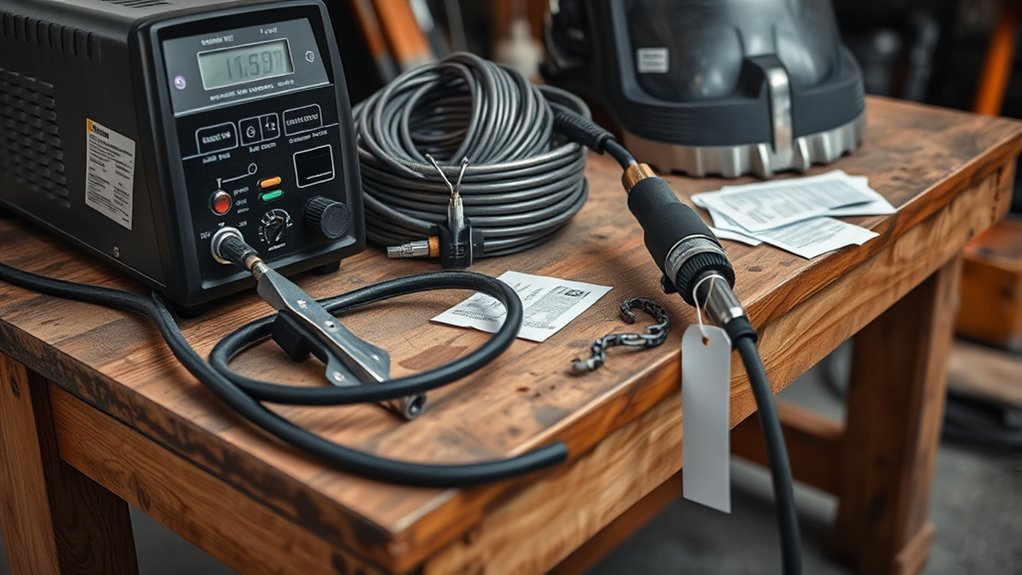You’ll typically pay $300–$2,000 for a capable MIG welder suited to hobby or light commercial work, while professional production units start above $2,000 and specialty systems can reach tens of thousands. Factor wire feeders, spool guns, and serviceable parts when comparing suppliers, and budget for gas, wire, and consumables. Check duty cycle, material compatibility, and warranty to match specs to your workflow — keep going for specific model price bands and supplier tips.
What Is a MIG Welder and How It Works
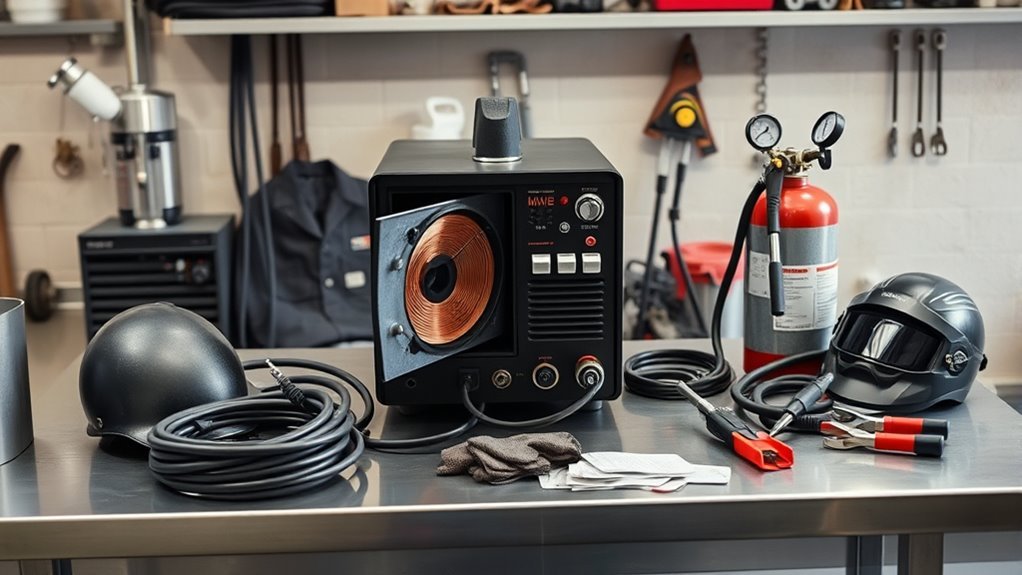
A MIG welder (Metal Inert Gas) uses a continuously fed solid wire electrode and a shielding gas to melt and join metals, so you get fast, clean welds suited to automotive work and general fabrication.
You’ll feed solid or flux-cored wire through a gun; the wire melts, fuses to parts, and shielding gas keeps contaminants out.
For procurement, specify wire diameter, gas type, and duty cycle to match production demands and reduce downtime. Choose units supporting both solid and flux-cored consumables for outdoor flexibility.
Inspect ventilation, grounding, and PPE to maintain welding safety and compliance.
Focus on vendors offering clear specs, warranty terms, and readily available consumables to minimize total cost of ownership.
Price Ranges: Entry-Level to Professional Machines
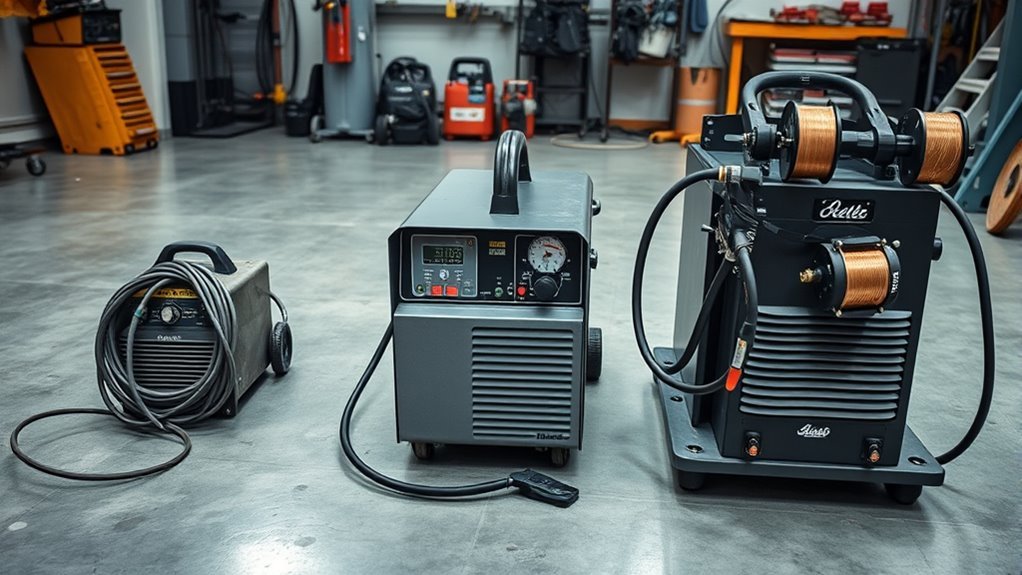
You’ll find entry-level MIG welders priced around $300–$500, which suit hobbyists and basic shop work while keeping upfront costs low.
Mid-range units jump to roughly $500–$2,000 for better duty cycles and features, and industrial/pro models start above $2,000 with top-end machines reaching into the tens of thousands for continuous production.
When comparing suppliers and specs, factor in added costs for multi-process capability, digital controls, and accessories that can greatly affect the final price.
Entry-Level Price Points
Three hundred dollars is a common starting point for entry-level MIG welders, putting basic units within reach for hobbyists and small-shop buyers who need light-duty performance without high upfront costs.
You’ll find most budget-friendly models under $500, offering core entry level features like single‑knob voltage control, 0.030–0.035 in. wire capacity, and short duty cycles suited to thin-gauge steel and occasional repairs.
From a supplier standpoint, prioritize units with clear specs, included safety gear, and accessible replacement parts.
For buying, use beginner tips: match amperage to projects, confirm spool and gas compatibility, and check warranty terms.
These machines keep initial investment low while letting you scale into mid-range equipment as needs grow.
Professional & Industrial Ranges
While entry-level units keep initial costs low, professionals and industrial buyers need to budget across a much wider price spectrum—from roughly $1,000 mid-range machines to professional systems exceeding $5,000—because brand, duty cycle, power output, and advanced features drive purchase and operating costs.
You’ll find mid-range units ($1,000–$3,000) balance affordability with better duty cycles, higher amperage, and more control options for demanding tasks.
For industrial applications, professional machines (>$5,000) deliver continuous operation, robust cooling, and modular accessories that support production environments.
When sourcing, compare specifications—duty cycle at rated amperage, input power, wire-feed consistency, and warranty terms.
Don’t forget consumables, preventive maintenance, and installation costs; high performance features cut downtime but raise upfront spend, so calculate total cost of ownership.
Brand Comparisons and Value by Feature
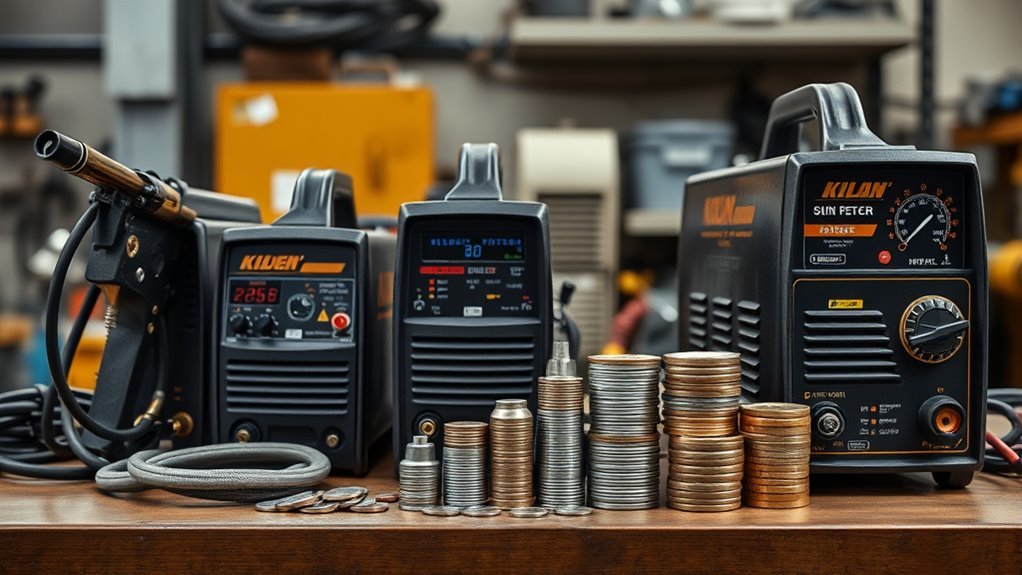
Because price often reflects features and support, comparing brands by specs and total ownership cost helps you pick the right MIG welder for your needs.
You’ll weigh MIG welder features and brand reputation against upfront price and long-term reliability.
Miller delivers top arc performance and Auto-Set ease at a premium, while Lincoln Electric emphasizes dependable builds and advanced wire feeding for pros.
Hobart targets value-seeking buyers with solid features at lower prices, and ESAB focuses on digital controls and innovation for higher-end workflows.
- Miller: premium arc control, higher acquisition cost, strong supplier support.
- Lincoln: reliable machines, advanced feed systems, mid-to-high pricing.
- Hobart/ESAB: Hobart balances cost and capability; ESAB adds digital sophistication.
Accessories and Add-Ons That Affect Total Cost
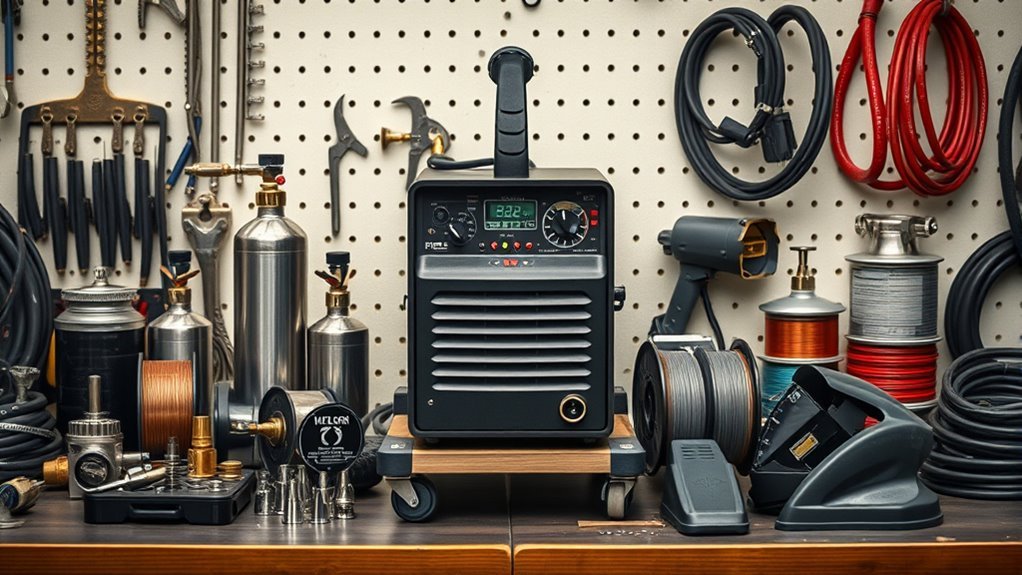
After you compare brands and specs, factor in the accessories and add-ons that actually drive up your total ownership cost.
After comparing brands and specs, include accessories and add-ons—those often determine your true ownership cost.
You’ll evaluate accessory benefits against upfront price: welding guns and wire feeders range $100–$1,000+, spool guns for aluminum add $200–$500, and proper running gear runs $300–$1,200.
For a clear cost breakdown, include small consumables—contact tips $5–$20 and gas nozzles/diffusers $10–$50 each—which multiply with replacement frequency.
As a buyer, prioritize suppliers offering compatible kits and volume pricing to lower per-unit expense.
Specify required features (duty rating, wire capacity, ergonomic gun options) to avoid costly upgrades.
Track accessory lifecycle and warranty terms to forecast replacement timing and total acquisition cost accurately.
Operating Costs: Gas, Wire, Maintenance, and Duty Cycle

When budgeting your MIG setup, factor in recurring gas and wire costs—shielding cylinders typically run $50–$150 each, while wire is about $0.05–$0.25 per pound depending on type.
You’ll also need to plan for routine consumable replacements (tips, nozzles, liners) and minor repairs, which commonly add $100–$300 a year plus per-item costs like $0.10–$2.00 for contact tips.
Finally, compare duty-cycle specs: higher-duty machines cost more up front but cut downtime and long-term operating expense.
Gas and Wire Expenses
One clear cost driver you’ll need to track is consumables: shielding gas cylinders typically run $20–$50 each depending on size and blend. Wire costs about $0.10–$0.30 per pound depending on type and diameter, and replaceable parts like contact tips and nozzles add roughly $50–$100 annually with normal use.
You’ll evaluate gas types (argon, CO2, mixes) against material and transfer mode; supplier pricing, cylinder refill vs. exchange, and purge losses matter. For wire, compare wire types (solid vs. flux‑cored), diameter, and spool size to optimize cost per joint.
Track consumption per project, negotiate bulk pricing, and specify compatible part numbers to avoid downtime and premium rush charges.
- Compare cylinder size and blend per application
- Calculate cost per pound by wire type and diameter
- Require supplier quotes and part numbers
Maintenance and Duty-Cycle
Now that you’ve quantified gas and wire consumption, factor maintenance and duty cycle into your per‑project cost model.
You’ll budget for routine parts—contact tips, nozzles, drive rolls—at $10–$50 each and expect occasional component replacement as part of supplier maintenance tips.
Compare machine specs: entry units (~$300) have lower duty cycle ratings than industrial models (>$1,000); a lower duty cycle increases downtime and labor cost per weld.
Inspect cables and consumables regularly to reduce unexpected repairs and extend lifespan, cutting long‑term operating expenses.
For purchasing, request supplier data sheets showing duty cycle at rated amperage and recommended maintenance intervals so you can accurately amortize maintenance and downtime into unit cost projections.
Choosing the Right Welder for Your Application and Budget
Because your projects and budget dictate what features matter most, start by matching welder specifications to the work you’ll do and the total cost of ownership you can afford.
You’ll factor in MIG welding techniques and budget considerations up front: hobbyists can buy reliable welders under $500 but should expect limited duty cycles, while industrial users usually invest $1,000+ for machines built for continuous production.
Match material capability (mild steel, stainless, aluminum) to the model, and account for maintenance, consumables, and accessories in your supplier quotes.
Prioritize machines with serviceable parts and clear uptime specs.
- Pick based on material compatibility and duty cycle
- Compare supplier support, parts availability, and consumable costs
- Balance initial price against projected operating expenses
Financing, Warranties, and Promotions to Lower Upfront Cost
Many buyers spread payments with financing plans, letting you acquire a higher-spec MIG welder now while managing monthly cash flow. You’ll find many machines eligible for financing options that split cost over months, so you can prioritize required specs—duty cycle, amperage range, spool gun compatibility—without draining capital.
Evaluate APR, term length, and any deferred-interest fine print from suppliers.
Also weigh warranty benefits: extended warranties (1–3 years) cover defects and reduce long-term maintenance risk, letting you compare total cost of ownership by model.
Look for manufacturer or retailer promotions—instant savings, rebates, free accessories, trade-in credits, and seasonal discounts—that lower upfront price.
Combine trade-in programs with promotions and financing to optimize procurement and spec-driven value.
Frequently Asked Questions
How Much Does MIG Training or Certification Typically Cost?
You’ll usually pay $200–$1,500 for MIG training programs and $50–$400 for certification options; choose supplier-oriented courses specifying curriculum, duration, and testing, and compare costs, credentials, and equipment access before committing.
Can MIG Welding Be Safely Done in Residential Garages?
Yes and no: you’ll want strict safety precautions, but with proper garage ventilation, fireproof surfaces, a supplier-recommended welder, respirator, grounding, and a small footprint you’ll manage compliant, cost-conscious MIG work without commercial shop overhead.
Are Used MIG Welders a Good Value Versus New Ones?
Yes — you can get good value from used equipment if you inspect specs, service history, and consumable availability; do a cost comparison versus new, prioritize trusted suppliers, warranty options, and necessary repairs to avoid surprises.
What Are Typical Resale Values for MIG Welders Over Time?
Like clockwork, you’ll see MIG welders lose value: expect 30–50% depreciated year-one, then 10–20% annually; watch welding market trends, equipment depreciation, check specs and preferred suppliers, prioritize warranties and consumable availability.
Do Insurance Policies Affect Owning or Operating a MIG Welder?
Yes — you’ll need insurance coverage for liability and equipment; policy limits determine claim payouts, so you’ll compare suppliers, verify specs, document serials, and choose cost-conscious deductibles to protect operations and resale value.
Conclusion
When shopping for MIG welders, you’ll likely pay anywhere from about $200 for a basic hobby unit to $3,500+ for a heavy-duty pro machine — note that roughly 60% of buyers choose mid-range models ($700–$1,500) for best value. Focus on specs like duty cycle, amperage range, and spool gun compatibility, and source from suppliers offering clear parts lists and warranties. Prioritize models that match your production needs to minimize operating and maintenance costs.

